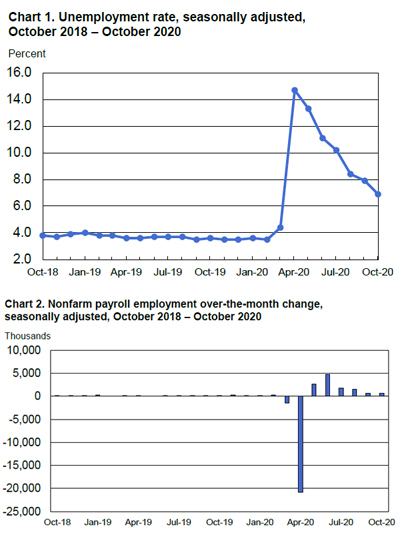 The U.S. economy added 638,000 non-farm jobs in October, above the 530,000-job growth expected by economists. The unemployment rate declined to 6.6 percent. October is the sixth consecutive month of both job growth and unemployment rate improvement.
The U.S. economy added 638,000 non-farm jobs in October, above the 530,000-job growth expected by economists. The unemployment rate declined to 6.6 percent. October is the sixth consecutive month of both job growth and unemployment rate improvement.
The Bureau of Labor Statistics (BLS) reported notable job gains in leisure and hospitality, professional and business services, retail trade and construction, while employment in government declined. Private-sector employers added 906,000 jobs, a pickup from September, offsetting a drop of 268,000 jobs in the public sector.
“As we await final presidential election results, the job growth reported from the Bureau of Labor Statistics this morning clearly demonstrates the underlying vitality of the hiring environment,” said Bert Miller, president and CEO of MRINetwork. “While 2020 continues to provide an unprecedented series of crises and challenges, we are seeing steady signs of optimism in economic growth. The attitude of our Network of over 300 executive recruitment offices can be characterized as “prudently bold.” We continue to invest in our business to meet demand for top talent across many of our industry sectors, including pharmaceutical, business services — specifically PR and marketing, software design and development, and construction — notably, building products and supplies as well as special trade construction.”
The BLS reported total nonfarm payroll employment rose by 638,000 and the unemployment rate declined to 6.9 percent. Notably the labor force participation rate increased by 0.3 percentage point to 61.7 percent in October, now only 1.7 percentage points below the February pre-Covid level.
Commenting on the October report, Bloomberg’s Market Reporter Kriti Gupta offers possible investor reaction to the positive news, “Here’s one way for the market to be able to read this report: Perhaps better payrolls data means less urgency for another round of stimulus. But remember, sometimes narrative is built around price swings as opposed to the other way around. So take the market reactions in the coming hours with a tub of salt.”
While recognizing the short-term impact of a virus spike many analysts see a solid rationale for optimism. “It’s hard to look at months or weeks past because you know what’s lying ahead and that’s an increase in virus cases. That continues to be the dark cloud looming ahead,” Jennifer Lee, senior economist at BMO Capital Markets, told Bloomberg. “But the fact that the jobless rate took such a big decline, that’s extremely encouraging.”
In October, 21.2 percent of employed persons teleworked because of the pandemic, down from 22.7 percent in September, reflecting an ongoing process as employers open places of work as commuting restrictions ease.
According to the BLS, these improvements in the labor market reflect the continued resumption of economic activity that had been curtailed due to the pandemic and efforts to contain it.
As reported by the BLS, employment in leisure and hospitality increased by 271,000 in October, with gains in food services and drinking places (+192,000); arts, entertainment, and recreation (+44,000); and accommodation (+34,000).
Professional and business services added 208,000 jobs in October, with temporary help services (+109,000) accounting for about half of the gain. Employment also increased in services to buildings and dwellings (+19,000), computer systems design and related services (+16,000), and management and technical consulting services (+15,000). Employment in professional and business services is 1.1 million below its February level.
In October, retail trade added 104,000 jobs, with almost one-third of the gain in electronics and appliance stores (+31,000). Employment also rose in motor vehicle and parts dealers (+23,000), furniture and home furnishings stores (+14,000), clothing and clothing accessories stores (+13,000), general merchandise stores (+10,000), and non-store retailers (+9,000). Employment in retail trade has risen by 1.9 million since April.
Construction added 84,000 jobs in October. Specialty trade contractors added jobs, both in the nonresidential (+28,000) and residential (+18,000) components. Employment also rose in heavy and civil engineering construction and in construction of buildings (+19,000 each). Construction has added 789,000 jobs in the last 6 months, now down by 294,000 since February.
Employment in healthcare and social assistance rose by 79,000 in October. Healthcare employment increased by 58,000, with the largest gains occurring in hospitals (+16,000), offices of physicians (+14,000), offices of dentists (+11,000), and outpatient care centers (+10,000). These increases were partially offset by a decline of 9,000 in nursing and residential care facilities. Social assistance added 21,000 jobs over the month.
Employment in transportation and warehousing increased by 63,000 in October, with gains occurring in warehousing and storage (+28,000), transit and ground passenger transportation (+25,000), and truck transportation (+10,000). By contrast, air transportation shed 18,000 jobs.
The BLS reported gains in employment in financial activities and manufacturing but at lower levels of increase versus September.
In October, government employment fell by 268,000. A decrease of 138,000 in federal government was driven by a loss of 147,000 temporary 2020 Census workers. Job losses also occurred in local government education and state government education (-98,000 and -61,000, respectively).
“We continue to remain focused on meeting client demand for top talent equipped with relentless work ethic, and capable of resilient management decision making and the ability to lead change in evolving business models,” said Miller.

 The U.S. economy added 638,000 non-farm jobs in October, above the 530,000-job growth expected by economists. The unemployment rate declined to 6.6 percent. October is the sixth consecutive month of both job growth and unemployment rate improvement.
The U.S. economy added 638,000 non-farm jobs in October, above the 530,000-job growth expected by economists. The unemployment rate declined to 6.6 percent. October is the sixth consecutive month of both job growth and unemployment rate improvement.
Connect with MRINetwork